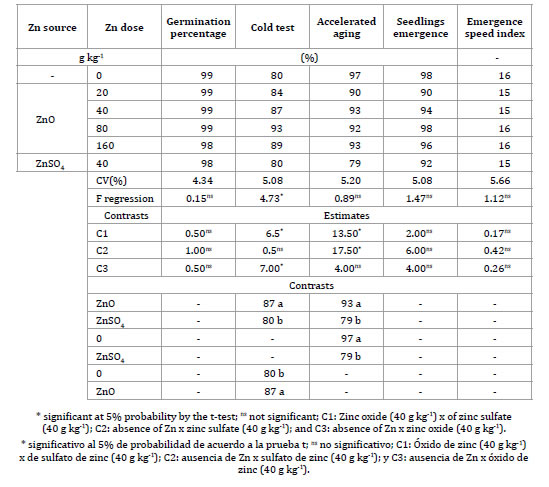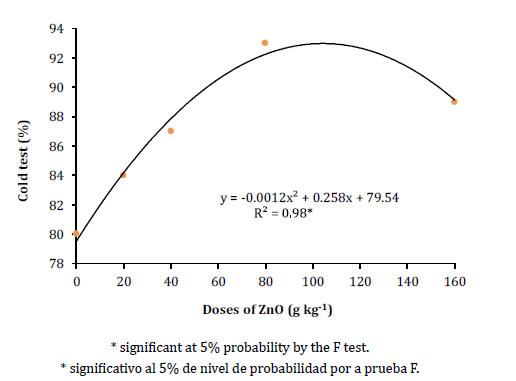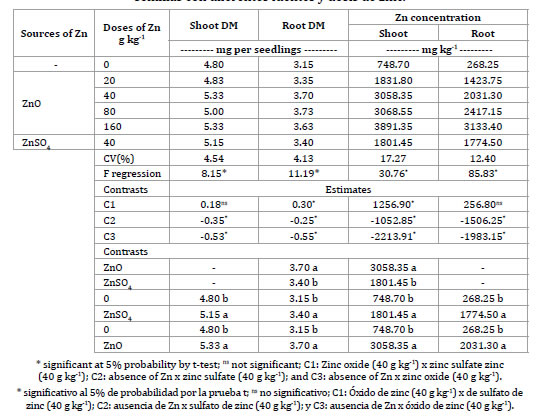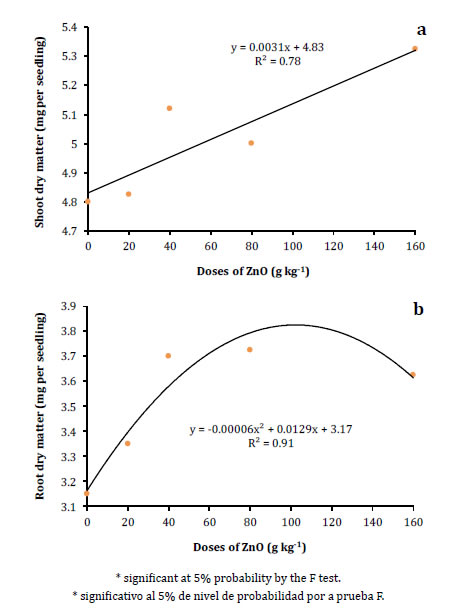
ORIGINAL ARTICLE
Effect of two sources of zinc on the physiological quality of seed and nutrition of rice (Oriza sativa) seedlings
Efecto de dos fuentes de zinc sobre la calidad fisiológica de semilla y nutrición de plántulas de arroz (Oriza sativa)
Flávia Mendes dos Santos Lourenço 1, Mariely de Abreu dos Santos 1, Charline Zaratin Alves 1, Cid Naudi Silva Campos 1, Ana Carina da Silva Cândido 1, Renato de Mello Prado 2, Gabriel Barbosa da Silva Júnior 3*
1 Universidad Federal de Mato Grosso do Sul. Campus Chapadão do Sul. Carretera MS-306. Zona Rural. C. P. 79560-000. Chapadão do Sul. Estado de Mato Grosso do Sul. Brasil.
2 Universidade Estadual Paulista "Julio de Mesquita Filho". Facultad de Agricultura y Ciencias Veterinarias. Departamento de Suelos y Fertilizantes. Vía de acceso Prof. Paulo Donato Castellane. CP: 14884-900. Jaboticabal. Estado de São Paulo. Brasil.
3 Universidade Federal de Piauí. Departamento de Ciencia de las Plantas. Centro de Investigación de Ciencias Agrícolas. Campus Ministro Petrônio Portella. C. P. 64049- 550. Teresina. Estado de Piauí. Brasil. * gabrielbarbosa@ufpi.edu.br
Originales: Recepción: 11/04/2018 - Aceptación: 18/05/2019
Rice seeds coating with microparticulate zinc oxide can maximize the absorption of this micronutrient by the seedling and favor seeds vigor when compared with zinc sulfate. This work aimed to evaluate the sources and doses of zinc in seed quality and in the nutrition of rice seedlings. The experiment consisted of a completely randomized design with four replications, five doses of zinc in the form of oxide (0; 20; 40, 80 and 160 g kg-1), and a control treatment of zinc in the form of sulfate (40 g kg-1). The following parameters were evaluated: germination, accelerated aging, seedlings emergence, emergence speed index, cold test, dry matter, and zinc concentration in the root and shoot of the seedlings. Seed coating with zinc, regardless of the source, improved seed physiological quality and seedling nutrition. Zinc sources did not affect germination; however, the oxide form induced better seed vigor, except for the highest dose (160 g kg-1). Increasing doses of zinc oxide augmented the concentration of this nutrient in rice seedlings dry matter. Zinc coating of rice seeds in the form of microparticulate, depending on the dose, can maximize seed vigor and increase the concentration of this micronutrient in the seedlings when compared with zinc sulfate, the traditional source.
Keywords: Micronutrient; Seed coating; Microparticulate zinc oxide
RESUMEN
El revestimiento de semillas de arroz con óxido de zinc microparticulado puede maximizar la absorción de este micronutriente por las plántulas y favorecer el vigor de las semillas en comparación con el sulfato de zinc. Este trabajo tuvo como objetivo evaluar las fuentes y dosis de zinc en la calidad de semillas y en la nutrición de plántulas de arroz. El experimento fue desarrollado en delineamiento completamente al azar con cuatro repeticiones, con un testigo sin aplicación de zinc, cuatro dosis de óxido de zinc (20, 40, 80 y 160 g kg-1 de Zn), y un tratamiento en la forma de sulfato de zinc, 40 g kg-1 de Zn. Se evaluaron los siguientes parámetros: germinación, velocidad de envejecimiento, emergencia de plántulas, índice de velocidad de emergencia, prueba fría de semillas, materia seca y acumulación de zinc en la raíz y parte aérea de las plántulas. La cobertura de semillas con zinc, independientemente de la fuente, mejoró la calidad fisiológica de las semillas y la nutrición de las plántulas de arroz. Las fuentes de zinc no alteraron la germinación; sin embargo, el óxido de zinc proporcionó un mejor vigor de las semillas, con la excepción de la mayor dosis, 160 g kg-1. El aumento en la dosis de óxido de zinc aumentó la acumulación de ese nutriente en la materia seca de las plántulas de arroz. El recubrimiento con zinc en semillas de arroz en forma de micropartículas, dependiendo de la dosis, puede maximizar el vigor de las semillas y aumentar la concentración de este micronutriente en las plántulas en comparación con el sulfato de zinc, que es la fuente tradicional utilizada por los productores.
Palabras clave: Micronutriente; Revestimiento de semillas; Oxido de zinc microparticulado
INTRODUCTION
Seed Zinc (Zn) application is an effective method to guarantee the greater availability and absorption of this element at the beginning of the crop’s development. At this stage, plants do not absorb large amounts of nutrients from soil or leaf applications due to the little developed root system and leaf area (21). Thus, Zn soil fertilization does not increase the concentration of this element in rice plants (Oryza sativa L.) (25).
Seed coating enhances nutrient distribution uniformity, reduces losses, lowers application costs, and allows the rational use of non-renewable natural reserves due to the small amounts used (3, 4). Moreover, Zn application may increase germination percentage, physiological response, and crop’s growth, especially in grasses (2), and depending on the source used.
Some studies have demonstrated divergent results for the different Zn sources applied to grasses. Tunes et al. (2012) reported that zinc sulfate (ZnSO4) did not increase the germination potential of wheat seeds, whereas Santos et al. (2017) verified that zinc sulphate application in maize seeds decreased germination and whole plant dry matter (DM). However, the application of zinc oxides (ZnO) forms to the seeds, increased growth and DM of sorghum (14) and maize (15) seedlings, as well as root and shoot Zn in rice seedlings (3). These results confirm the higher efficiency of ZnO when compared with ZnSO4. To the moment, studies have reported the use of non-microparticulate oxides; therefore, the use of a ZnO source with microparticles in the range of 1.90 to 18.00 μm could be tested in order to find if it may increase the benefits in germination, growth, and nutrition of rice seedlings.
Considering the aforementioned, the work hypothesis is that plants absorb more ZnO in the form of microparticulate than conventional ZnSO4 due to the particles size. In addition, the use of ZnO promotes the slower zinc availability in relation to the soluble source, ZnSO4. This fact favors a high absorption of the element without inducing toxicity, which normally occurs with ZnSO4 seed application, as observed in maize seedlings (19).
Thus, rice seeds coating with microparticulate ZnO can maximize the absorption of the micronutrient in the seedling and favor seed vigor and seedling development when compared with zinc sulfate. This work aimed to evaluate the sources and doses of zinc in seed quality and in the nutrition of rice seedlings, cultivar ANA 5015.
MATERIAL AND METHODS
The study was carried out at the Seed Technology Laboratory of the Federal University of Mato Grosso do Sul, Campus of Chapadão do Sul - CPCS/UFMS, using seeds of the rice cultivar ANA 5015.
The experiment consisted of a randomized complete design with four replications. Treatments consisted of a control without application of Zn (0 g kg -1 of Zn), four doses of microparticulate zinc oxide (20, 40, 80, and 160 g kg-1 of Zn in seeds), corresponding to the amount of Zn to coat 1 kg of seed and a treatment containing a dose of 40 g kg-1 of Zn in seeds, with zinc sulfate (35% Zn). The zinc oxide source contains 50, 90, and 100% of the particles with a diameter below 1.90; 8.96 and 18.00 μm, respectively. In addition, 85% of Zn is associated with lignin at the concentration of 1,0 g L-1 in order to keep the zinc in suspension. Zinc doses were chosen according to recommendations for application of Zn in seed treatment (15).
Seed coating was carried out by hand in a plastic bag, by mixing the respective dose of ZnO with 200 g of seeds moistened with 50 mL of water and shaking for three minutes until complete homogenization. The effects of the treatments were evaluated by germination and vigor tests.
Germination test was carried out with four replications of 50 seeds distributed on germitest paper, moistened with water equivalent to 2.5 times the mass of the non-hydrated substrate, in a germinator at 25°C. The evaluation was carried out 14 days after installation (11).
The evaluation of the accelerated aging used four replications and 50 seeds per treatment and was carried out in gerboxtype boxes (11.5 x 11.5 x 3.5 cm) covered by a metal screen. Seeds were distributed in a single layer, containing 40 mL of sodium chloride solution (40 g NaCl/100 mL H2O), with 76% RH (6). The boxes were covered and maintained in a Biochemical Oxigen Demand (B.O.D) for 24 hours at 41°C (21). After the aging process, seeds were subjected to the germination test, as previously described, and evaluated five days after sowing.
Seedlings emergence was evaluated by placing the seeds in expanded polystyrene box containing Plantmax® substrate with two daily irrigations. Seedlings were evaluated at 15 days after sowing, by counting the emerged seedlings (12), using four replications of 50 seeds. The emergence speed index was calculated by the Maguire formula (8), with daily evaluations from the beginning of seedlings emergence, by counting the number of seedlings emerged for 15 days after sowing.
For the cold test, four replications of 50 seeds were used for each treatment. Seeds were distributed in germitest paper rolls and moistened with water equivalent to 2.5 times the mass of the non-hydrated substrate. The rolls were stored in plastic bags and maintained in a B.O.D. chamber at 10°C for seven days. Afterwards, they were transferred to the germinator at 25°C, where they remained for another 7 days, followed by counting normal seedlings.
For seedlings DM (dry matter), 20 seeds were sown in germitest paper previously moistened with water equivalent to 2.5 times the mass of the non-hydrated substrate, remaining in the germinator at 25°C for 19 days. Shoots and roots of normal seedlings of each replication were separated using a blade and placed in kraft paper bags and dried in a forced-air- circulation-oven at 65°C until constant weight. Afterwards, shoot and root DM (mg per seedling) were obtained. The Zn concentration was determined according to the methodology proposed by Bataglia et al. (1983).
Data were subject to ANOVA, and the doses of ZnO were analyzed by polynomial regression. Three statistical contrasts were established and analyzed by the t-test at 5% probability: ZnO (40 g kg-1) x ZnSO4 (40 g kg-1) (C1), absence of Zn x ZnSO4 (40 g kg-1) (C2), and absence of Zn x ZnO (40 g kg-1) (C3).
RESULTS AND DISCUSSION
For germination, no significant difference was observed between treatments (table 1, page 99).
Table 1. Germination percentage (%), cold test, accelerated ageing, seedlings emergence, and speed index of rice seeds emergence in function of coating with different zinc sources and doses.
Tabla 1. Porcentaje de germinación, prueba de frío, envejecimiento acelerado, emergencia de plántulas e índice de velocidad de emergencia de semillas de arroz en función del recubrimiento con diferentes fuentes y dosis de zinc. Estos valores se expresan en porcentaje (%).

However, this experiment does not consider the growth rate, which is fundamental for a successful seedling establishment. Therefore, if the seedlings development is relatively slow, but is complete at the expected period of time for the laboratory test, the results may not be the same under less favorable environmental conditions (10).
Although zinc coating did not affect the germination, it influenced seeds vigor. In the cold test, when comparing the oxide form of Zinc with respect to the sulfate form, contrast 1 (C1), and the absence of zinc, contrast 2 (C2), the oxide presented higher averages of seedlings (table 1, page 99). Seeds under adverse conditions of temperature and humidity presented a decreased germination. In these circumstances, zinc oxide was beneficial in relation to the absence of zinc, causing Zn absorption even under low seed metabolism conditions.
The increase of zinc oxide doses increased the values of normal seedling germination in the cold test, with a maximum value of 107.5 g kg-1 of Zn in seeds (figure 1, page 100).

Figure 1. Cold test of rice seedlings in function of seed coating with increasing doses of zinc oxide.
Figura 1. Prueba en frío de plántulas de arroz en función del revestimiento de semillas con dosis creciente de óxido de zinc.
This fact confirms the beneficial effect of zinc on seeds under adverse conditions of temperature and humidity since this element may have an antioxidant effect, contributing abiotic stresses tolerance or avoidance (7, 24).
In the accelerated aging, when comparing zinc oxide with zinc sulfate, the oxide showed a higher percentage of seedling standards (C1). The same was observed when comparing the absence of zinc in relation to sulphate (C2).
The absence of this source favored the increase of normal seedlings (table 1, page 99). This test simulates stressful conditions in the seeds due to high temperature and high humidity, and under these conditions, Zn in the form of sulfate impaired their performance.
Seedlings emergence and emergence speed index showed no difference between treatments (table 1, page 99). These results are in agreement with those of Pletsch et al. (2014), Smiderle et al. (2008), and Tunes et al. (2012), which presented no differences for these parameters in canola, bean, and wheat seeds, respectively, using zinc sulfate coating. In some cases, the application of ZnSO4 may decrease the seed germination potential, as observed by Santos et al. (2017) and Xavier et al. (2016), who evaluated doses of Zn sulfate applied to maize seeds and stylosanthes, respectively. Results indicated greater root DM for the Zn applied in the form of zinc oxide when compared with sulfate oxide. Moreover, DM values were higher when using the Zn sources than in the absence of Zn (table 2, page 101).
Table 2. Shoot dry matter, root dry matter, and zinc concentration in the shoots and roots of rice seedlings in function of seed coating with zinc sources and doses.
Tabla 2. Materia seca de la parte aérea, masa seca de raíces y concentración de zinc en la parte aérea y en las raíces de plántulas de arroz en función del revestimiento de semillas con diferentes fuentes y dosis de zinc.

In sorghum seeds, the use of zinc oxide increased shoot and root DM, resulting in greater efficiency when using the micronutrient, despite the lower absorption efficiency when compared to the sulfate. In addition, the application of zinc sulfate decreased whole plant DM (14).
An increase in root DM was observed up to the dose of 102.7 g kg-1 of Zn (oxide form) in seeds (figure 2b, page 102).

Figure 2. Shoot dry matter (a), and root dry matter (b) of rice seedlings in function of seed coating with doses of zinc oxide.
Figura 2. Materia seca de la parte aérea (a) y raíz (b) de plántulas de arroz en función del revestimiento de semillas con dosis de óxido de zinc.
Galrão et al. (1996) reported different results for the coating of maize seeds, with an increase in root DM with up to 40 g kg-1 of Zn in seeds when using oxide. Prado et al. (2007b) evaluated doses of up to 40g kg-1 of Zn in seeds (zinc oxide and zinc sulfate) in a maize crop and observed a quadratic adjustment for plant DM, with increasing values when using zinc oxide and decreasing values seeds, Prado et al. (2008) observed a decreasing linear effect with the use of zinc sulfate and no effect with the use of zinc oxide for DM yield. However, zinc sulfate decreased root DM yield when compared with zinc oxide. Thus, high concentrations of Zn in the plant can be toxic and consequently affect DM yield (10).
For shoot DM, both ZnO and ZnSO4 lead to higher values when compared with the absence of Zn (table 2). An increasing linear adjustment was observed for shoot DM with increasing doses of zinc oxide (figure 2a, page 102). Rozane et al. (2008) evaluated zinc oxide and zinc sulfate in rice and verified that sources lead to similar increments of seedlings DM.
The authors also stated that the doses of zinc, regardless of the source, linearly increased whole plant DM. Nevertheless, Prado et al. (2008), in a study on sorghum seeds, observed that the doses of zinc quadratic and linearly affected shoot DM yield when using zinc sulfate and zinc oxide, respectively.
Zinc sources significantly affected the Zn concentration in shoot DM (table 2, page 101). Zinc oxide showed higher values when compared with zinc sulfate and absence of Zn, with a greater absorption seed of the oxide and greater translocation of Zn to the seedling (table 2, page 101).
Yagi et al. (2006) used doses of zinc sulfate in sorghum seeds and observed significant effects on zinc concentrations in shoots. A quadratic regression was observed for zinc concentration in shoots (figure 3a) as a function of Zn doses in seedlings, with maximum Zn concentration of 2988,5 mg kg-1 in shoot, corresponding to the application of 136,3 g kg-1 of Zn in seedlings.

Figure 3. Zinc concentration in shoot (a) and root (b) in rice seedlings in function of seed coating with doses of zinc oxide.
Figura 3. Concentración de zinc en la parte aérea (a) y en las raíces (b) en plántulas de arroz en función del revestimiento de semillas con dosis de óxido de zinc
These results are in agreement with those reported by Prado et al. (2007c) in maize seeds, that observed a quadratic increase in the Zn concentration in shoots and roots by using zinc sulfate and a linear increase when using zinc oxide.
No difference between the sources was observed in Zn concentration of roots. However, a greater Zn absorption was verified when using zinc oxide. Regarding the absence of Zn, the sources presented greater nutrient concentration (table 2, page 101).
.A positive quadratic effect was observed for zinc concentration in roots of rice seedlings (maximum value of 3.149,9 mg kg-1) when using zinc oxide up to the dose of 138.2 g kg-1 in seedlings (figure 3b, page 103). Plants tolerance to zinc excess is related to the complexation of the metal in the cytoplasm of the cells by the exudation of chelating substances in the roots (22).
Rozane et al. (2008) reported that the increase in the doses of zinc quadratically increased the zinc concentration and accumulation in the root when using both zinc sulfate and zinc oxide. In maize seeds coated with zinc, Prado et al. (2007) observed that the increase in the doses of zinc resulted in a quadratic increase of the nutrient concentration in root when using zinc sulfate; a linear increase of the nutrient concentration when using zinc oxide, and a quadratic increase in Zn accumulation for both sources.
CONCLUSION
Zinc sources did not change the germination; however, the oxide form provided better seed vigor, except for the highest dose (160 g kg-1). Increases of zinc oxide doses augmented the concentration of this nutrient in rice seedlings DM, when compared with zinc sulfate, which is the traditional source.
1. Bataglia, O. C.; Furlani, A. M. C.; Teixeira, J. P. F.; Furlani, P. R.; Gallo, J. R. 1983. Métodos de análise química de plantas. Instituto Agronômico de Campinas, Boletim Técnico. 48 p.
2. Beutler, A. N.; Silva, V. N.; Deak, E. A.; Burg, G. M.; Schmidt, M. R.; Toebe, M. 2014. Zinc doses, sources and application times: seed physiological potential and flooded rice yield. Australian Journal of Crop Science. 8(11): 1517-1525.
3. Dias, M. A. N.; Cicero, S. M. 2016. Effect of copper carbonate and zinc oxide applied to seeds on copper and zinc uptake by maize seedlings. Bragantia. 75(3): 286-291.
4. Farooq, M.; Wahid, A; Siddique, K. H. M. 2012. Micronutrient application through seed treatments - a review. Journal of Soil Science and Plant Nutrition. 12: 125-142.
5. Galrão, E. Z. 1996. Métodos de aplicação de zinco e avaliação de sua disponibilidade para o milho num Latossolo Vermelho-Escuro, argiloso, fase cerrado. Revista Brasileira de Ciência do Solo. 20(2): 283-289.
6. Jianhua, Z.; McDonald, M. B. 1996. The saturated salt accelerated aging test for small seed crops. Seed Science and Technology. 25(1): 123-131.
7. Ma, D.; Sun, D.; Wang, C.; Ding, H.; Qin, H.; Hou, J.; Huang, X.; Xie, Y.; Guo, T. 2017. Physiological responses and yield of wheat plants in zinc-mediated alleviation of drought stress. Frontiers in Plant Science. 8(860): 01-08.
8. Maguire, J. D. 1962. Speed of germination-aid in selection and evaluation for seedling emergence and vigor. Crop Science. 2(2): 176-177.
9. Marcos Filho, J. 1999. Teste de vigor: importância e utilização. In: Krzyzanowski, F. C.; Vieira, R. D.; Neto, J. B. F. Vigor de sementes: conceitos e testes. Londrina. Brasil. Abrates. 1-20.
10. Mengel, K.; Kirkby, E. A. 1987. Principles of plant nutrition. Bern: International Potash Institute. 687 p.
11. Ministério da Agricultura, Pecuária e Abastecimento (MAPA/ACS). 2009. Regras para análise de sementes. Secretaria de Defesa Agropecuária. Brasilia. Brasil. Avaliable in: http:// www.agricultura.gov.br/assuntos/insumos-agropecuarios/arquivos-publicacoes insumos/2946_regras_analise__sementes.pdf. Acesso em: 15 set. 2018.
12. Nakagawa, J. 1999. Testes De vigor baseados no desempenho das plântulas. In: Krzyzanowski, F. C.; Vieira, R. D.; França Neto, J. B. (Eds.). Vigor de sementes: conceitos e testes. Londrina. Brasil. Abrates. 1-24.
13. Pletsch, A.; Silva, V. N. Beutler, A. N. 2014. Tratamento de sementes de canola com zinco. Revista de Ciências Agrárias. 37(2): 241-247.
14. Prado, R. M.; Mouro, M. C. 2007a. Fontes de zinco aplicado em sementes de sorgo cv. BRS 310 e o crescimento inicial. Ciências Agrárias. 28(3): 355-364.
15. Prado, R. M.; Mouro, M. C.; Natale, W. 2007b. Crescimento Inicial e Nutrição de Milho Cultivar P30k75 Submetido à Fertilização de Zinco via semente. Revista Brasileira de Agrociência. 13(4): 495-501.
16. Prado, R. M.; Natale, W.; Mouro, M. C. 2007c. Fontes de Zinco aplicado via semente na nutrição e crescimento inicial do milho cv. Bioscience Journal. 23(2): 16-24.
17. Prado, R. M.; Romulado, L. M.; Rozane, D. E. 2008. Aplicação de zinco em sementes de sorgo cv. BRS 304: efeitos na nutrição e no crescimento inicial. Acta Scientiarum. Agronomy. 30(4): 471-478.
18. Rozane, D. E.; Prado, R M.; Romualdo, L. M.; Simões, R. R. 2008. Resposta de plântulas de arroz cv. BRS - soberana à aplicação de zinco via semente. Ciência e Agrotecnologia. 32(3): 847-854.
19. Santos, A. P.; Morais, O. M.; Prado, R. M.; Leal, A. J. F.; Silva, R. P. 2017. Relation of toxicity in corn seeds treated with zinc and salicylic acid. Communications in Soil Science and Plant Analysis. 48(10): 1123-1131.
20. Smiderle, O. J.; Carvalho, M. V.; Miguel, M. H.; Cicero, S. M. 2008. Tratamento de sementes de feijão com micronutrientes embebição e qualidade fisiológica. Agro@mbiente On-line. 2(1): 22-27.
21. Tunes, L. M.; Pedroso, D. C.; Tavares, L. C.; Barbieri, A. P. P.; Barros, A. C. S. A. Muniz, M. F. B. 2012. Tratamento de sementes de trigo com zinco: armazenabilidade, componentes do rendimento e teor do elemento nas sementes. Ciência Rural. 42(7): 1141-1146.
22. Wang, J.; Evangelou, V. P. 1994. Metal tolerance aspects of plant cell wall and vacuole: handbook of plant and cropphysiology. Tucson, The University of Arizona. 325 p.
23. Yagi, R. M.; Simili, F. F.; Araújo, J. C.; Prado, R. M.; Sanchez, S. V.; Ribeiro, C. E. R.; Barretto, V. C. M. 2006. Aplicação de zinco via sementes e seu efeito na germinação, nutrição e desenvolvimento inicial do sorgo. Pesquisa Agropecuária Brasileira. 41(4): 655-66.
24. Yavas, I.; Unay, A. 2016. Effects of zinc and salicylic acid on wheat under drought stress. Journal of Animal and Plant Science. 26: 1012-1018.
25. Yin, H. J; Gao, X. P.; Stomph, T. J.; Li, L. J.; Zhang, F. S.; Zou, C. O. 2016. Zinc concentration in rice (Oriza sativa L.) grains and allocation in plants as affected by different zinc fertilization strategies. Communications in Soil Science and Plant Analysis. 47(6): 761-768.
AGRADECIMIENTOS
Coordenação de Aperfeiçoamento de Pessoal de Nível Superior (CAPES) y Programa Nacional de Cooperação Acadêmica (PROCAD) - Edital 71/2013.